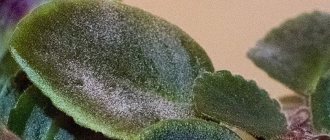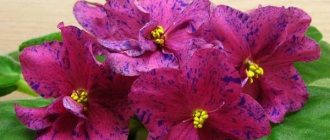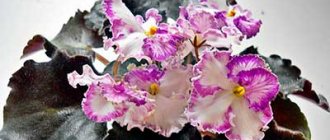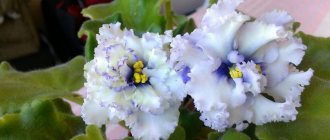A plant similar to the common European violet was discovered during one of the walks in the local mountains by the German governor in the East African region, Baron named Saint-Paul.
By the end of the 19th century, Saintpaulia appeared in Germany and, subsequently, throughout Europe.
In our country, the Uzambara violet begins to be bred within a couple of decades , although it grows mainly in botanical gardens. The selection of Saintpaulias in the USSR began in the mid-20th century.
Violet RM-Circus Princess (N. Skornyakova)
Unusual violet Circus Princess.
The variety RM-Circus Princess belongs to the genus Violet Uzambarskaya, which is part of the botanical family Gesneriaceae of the order Clear-flowered. The botanical name of this genus is Saintpaulia.
History of the variety
The author of the variety RM-Circus Princess, Kursk breeder is Natalya Skornyakova . Natalia's varieties and seedlings are distinguished by their delicate color, often double, with light or bright green foliage.
Photo and description of sotra
Saintpaulia RM-Circus Princess blooms with large semi-double or double multi-layered flowers. Soft pink prints and blue fantasy pattern of strokes and segments.
It has a standard, even rosette made up of medium green leaves. The variety is characterized by abundant cap flowering.
The most popular varieties and their photos
Dadoyan has been breeding for about 5 years and during this time there are no more than 20 varieties of her selection. But the most commonly heard representatives in the world are the following:
"Water"
The flowers are bright deep blue, double, with dashes or lightened fragments along the edges of the petals of a pinkish tint. Along the edge of the petals there is a green ruffled border. The leaves are dark, quilted with a slightly wavy edge. Sometimes the leaves have red spots on the white backside. The violet grows quickly, the buds blooming very slowly, but simultaneously.
"Grinya"
The flowers are large, fluffy, semi-double and double, white with a thick ruffled green ruffle along the edge of the petals. The leaves are regular, lanceolate, slightly pubescent. It blooms with a magnificent bouquet, abundant flowering.
"Droplet"
This is a plant with large, semi-double, white flowers with wavy edges of the petals. Each flower has a distinct purple eye in the center of the bud. The leaves are elongated, light green in color.
The rosette is neat at the root. The plant blooms quickly, blooms profusely and for a long time.
"Maria"
Curly sport from the Fairy variety. It has large, heavily double pink flowers with a raspberry coating and a green ruffle along the pom-pom flower.
"Snow White"
The flowers are large, in the form of fluffy terry balls of pure white color with wavy edges of the petals. The leaves of the violet are glossy, wavy, bright green. The plant stands out for its abundant bouquet flowering.
"Wild Cherry"
The flowers of the plant are large, semi-double, bright cherry color with a clear, wide white border. Externally, the flower can be compared to a multi-pointed three-dimensional star. The leaves are dark green, spoon-shaped, lanceolate. Wild cherry is a sport from the Frosty Cherry variety.
"Running on the waves"
The flowers are huge, double, variable white with dark blue fragments interspersed. The leaves are regular, dark green. The rosette is neat at the root. The plant blooms quickly, blooms profusely and for a long time.
"Georgia"
The flowers are large, double, bright pink with a crimson border, the edges of the border are decorated with a thick, corrugated green ruffle. Strong peduncles, curly basal rosette.
The leaves are regular, slightly pubescent. Georgia contains a lot of buds on the bush, the flowering period is short.
"Poet Yuri Gal"
This is a soft pink, “porcelain” violet, it got its name in honor of the poet Gal, whose prisoner Tatyana’s father once saved in Stalin’s camps. Then Dadoyan had one goal - to save, survive and joy will come.
The plant is capricious; if not properly cared for, it quickly dies, but its goal is also to survive and give joy.
Caring for a plant at home
Uzambara violets are often found in :
- Apartments;
- And offices.
Caring for such plants is not difficult, you just need to strictly follow agricultural technology .
Conditions of detention
In order for the Circus Princess to bloom brightly and for a long time, and delight her with green foliage, you need to provide her with :
- Optimal conditions;
- And good care.
For good flowering, the variety requires proper care.
Proper watering and fertilizing
Violets are watered only when the top layer of the substrate is dry. The frequency of watering and the speed of soil drying depend on many factors :
- Violet age;
- Socket size;
- Composition and properties of soil.
To optimize care, all violets in the collection should be planted in the same soil . Water for irrigation needs to be at room temperature, standing for several hours.
ADVICE! It is convenient to water violets with a watering can with a thin long spout or a large medical syringe. They try to pour water onto the border of the substrate at the edge of the pot, so that drops do not remain on the petioles and the growing point.
Violets are fed based on the following important points:
- Saintpaulias need nitrogen when the plant quickly gains green mass, that is, during the period from transplanting to flowering;
- Phosphorus and potassium help to lay a lot of buds and bloom profusely for a long time, so they are added in spring and summer;
- Microelements strengthen the plant’s immunity and resistance to adverse factors;
- Remember that replanting is often more beneficial for a plant than a series of fertilizing.
many forms of fertilizers available commercially :
- Granules;
- Sticks;
- Powders;
- Liquids.
When choosing nutrition for violets, give preference to liquid forms containing chelated compounds of nutrients.
Lighting and temperature
RM-Circus Princess, like most Saintpaulias, prefers bright, diffused sunlight . The optimal location is eastern or western window sills.
In winter, Saintpaulias require additional lighting.
Daylight hours for Saintpaulias should be at least 10 hours . If the lighting is not enough, use a phytolamp; if the light is too bright, the plants will be shaded.
ATTENTION! Lack of light affects the shape of the outlet. Without the sun, it becomes loose and spreading due to elongated petioles.
Air humidity
Humidity is very important for Uzambara violets :
- Soils;
- And air.
These plants are more comfortable if the air humidity is 50-60%:
- An adult Saintpaulia, with good lighting and proper watering, can bloom in drier air;
- For children and rooted petioles, a higher humidity level is needed - about 70%.
What kind of soil does he prefer?
High-moor peat must be included in mixtures for planting violets . Most often, store-bought planting mixtures are not suitable for these flowers, since they contain low-lying peat with an acidic environment.
The soil mixture for Saintpaulia should have the following properties :
- Be moisture-intensive;
- Be light, breathable;
- Contain macro and microelements, without excess nitrogen;
- Weak acid reaction;
- Free from pests and pathogens.
Soil for violets can be bought at a flower shop.
When making up a soil mixture for planting violets, you can follow two approaches :
- A two-component mixture is prepared from high-moor peat with the addition of cultivators (vermiculite, perlite, charcoal). Growing in such a substrate requires frequent feeding;
- A complex mixture is prepared , balanced in chemical composition. Violets planted in such a mixture do not need to be fed.
Pruning and hygiene
The rosette of an adult Saintpaulia is formed to increase decorativeness. Formation rules :
- A regular rosette is formed by 3-4 tiers of leaves;
- The leaf blades should be arranged like tiles on a roof, only partially overlapping each other;
- Leaves of lower tiers are removed;
- Empty flower stalks, diseased, damaged leaves are cut off.
Saintpaulias have axillary flower stalks, so without a healthy, properly formed rosette of leaves, there will be no active flowering .
ADVICE! By removing the lower leaves as the rosette grows, we expose the stem of the violet and the plant becomes unsightly. If this happens to your Isabella, sprinkle the stem with soil, or replant the plant with a fresh one.
The leaves of violets are covered with thin fibers, dust accumulates between them :
- Spoiling the appearance;
- Impairing gas exchange.
Contrary to general opinion, violets can and should be given a hygienic shower . Before the procedure:
- Cover the soil with film;
- Then, gently rinse each leaf with warm water.
Saintpaulia must be washed periodically.
Flowers should dry in the shade so that yellow spots do not appear on the leaves.
Reproduction methods
RM-Circus Princess reproduces well by vegetative means .
methods :
- Rooting leaf cuttings. The leaf will take root in water, soil, vermiculite;
- Kids . They are not formed often, but they take root well; such a plant will bloom faster than one grown from a leaf cutting.
Transplant rules, rejuvenation
Replanting is an excellent reason to rejuvenate the plant. They try to carry out the transplant procedure every 1-2 years. Ideally - every spring . If you leave a violet in old soil for more than 2 years:
- It will stop blooming profusely;
- The foliage will fade.
Saintpaulia is usually transplanted in March. The size of the pot does not change. The main task of replanting is to stimulate the growth of young roots; they will provide water and nutrition for new leaves and peduncles.
Transfer rules:
- It is better not to water the violet before transplanting. Dried soil easily falls off the roots and will not damage them;
- Carefully remove the roots, free them from most of the soil;
- Cut off old, diseased roots and leaves;
- Place the roots in new soil, cover with soil up to the leaves;
- Water the flower and add soil.
Features of cultivation
Cultivation of this variety of violet can please flower growers with the occurrence of a minimum of unpleasant surprises, which do not harm the decorative condition of the plant so much and which the correct agricultural technology can help to cope with.
Difficulty of independent growth in indoor collections
The violet of this variety is distinguished by its unpretentious character, easy adaptation to the microclimate of any room, endurance and chic decorativeness.
The characteristics of the variety oblige Saintpaulia to maintain the fresh appearance of the corollas for a long time, which is not so common in light-flowered varieties and is especially pleasing to gardeners.
Other favorable features of the violet’s appearance include:
- fundamentally independent formation of sockets;
- neat compactness of the leaf bush;
- a magnificent combination of spectacular marshmallow-shaped corollas, pastel shades and fancy spraying on the petals;
- gorgeous bouquets of huge flowers.
The nuances of the development of Saintpaulia include:
- slow development of bushes and late first flowering;
- the need to control the lighting regime - the variety loves light, its decorative effect is clearly manifested in intense lighting, especially in the natural spectrum;
- the plant raising its “arms and leaves” upward in the absence of light;
- the possibility of stretching peduncles and their some weakness - calcium nitrate will help correct this situation with foliar feeding during the budding period.
Breeding specifics
It is possible to carry out the phase purely vegetatively:
- children from the sheet;
- layering from mature plants.
The violet variety is characterized by low fertility and long maturation of children.
Temperature
CAREFULLY! Excessive heat when keeping a plant in a hot home microclimate can cause the flowers to fade into a thick pink color until the contour edge and fantasy are almost completely smoothed out.
To preserve the decorative integrity of flowering specimens, it is recommended to especially protect them from elevated temperatures at the time of flowering.
You should not allow sharp temperature contrasts and cold drafts in a room with blooming violets - there is a danger of failure of flowering and shedding of buds.
Peduncles
Flowers of varietal violets always form elongated peduncles , which are capable of holding heavy bouquets of corollas in an upright position only at the beginning of flowering.
When all the flowers are fully opened, the strength of the peduncles is not enough.
Type of flowering
Varietal violet gradually and steadily begins to form voluminous bouquets from fabulously sized buds, the effectiveness of which intensifies with each subsequent wave of flowering.
Vitality of flowers
The corollas of the Saintpaulia variety can maintain a fresh decorative appearance for more than one month.
Features of flowering, growth and reproduction
RM-Circus Princess:
- Unpretentious;
- Growing and developing rapidly;
- Easy to propagate;
- And undergoes a transplant.
How long does it take to grow an adult plant?
Sort quickly :
- Growing;
- And it gains color.
It takes no more than 6-7 months from a rooted leaf cutting to an adult flowering plant
How are varietal characteristics transmitted?
Violet RM-Circus Princess reproduces vegetatively quite simply . The characteristics of the variety are fully conveyed, but sports are also common.
Flowering in hot and cool conditions
Isabella most fully displays varietal characteristics at a temperature of 240C:
- At 250C and above, the flowers will become even more saturated in color;
- In cool weather, the petals lighten, and the white spot in the center becomes more pronounced.
ATTENTION! Temperatures above +280C and below +160C are dangerous for violets.
What do flower stalks look like?
Light green, strong. Each bears 2-3 flowers .
The violet peduncle bears 2-3 flowers.
Is it possible to achieve cap flowering?
Flowering is bouquet , lush and abundant.
Bud lifespan
Each flower lives up to 4 weeks .
Description of the best varieties
Most often the names of three violets of Tatiana's selection come up. What do these unique flowers look like?
"Fairy"
Plant selection 2010. Appearance:
- the flowers are large, double, white with a pink tint in the center, they have a gorgeous pink wavy edge, which is highlighted by fuchsia dots;
- the flower stalks of the plant are dense and strong;
- the socket is smooth and compact;
- leaves are straight, regular in shape, quilted, wavy along the edge, dark green, glossy;
- the stem is short, emerging from a basal leaf rosette;
- each flower has its own pedicel;
- pedicels slightly pubescent.
Peculiarities:
- when the flower just opens, it is pure white, the pink border appears over time;
- violet loves a lot of light;
- sometimes a sport plant grows - this is a modified flower, the border does not appear, pink stains appear slightly on the double bud;
- the plant grows slowly.
We invite you to read the full description of the Fairy violet in another material.
"Raspberries"
Plant selection 2011. Appearance:
the flowers are large, double, like a pompom, bright crimson, the edges of the petals are wavy;- leaves are regular, spoon-shaped, dark green, lanceolate, glossy, slightly pubescent;
- stems are short, pubescent, emerging from a basal rosette;
- The socket is compact and folds out well;
- one stem may have several pedicels (inflorescence umbrella);
- erect flower stalks;
- the buds are heavy.
Peculiarities:
- during the flowering period, flowers bloom slowly but amicably;
- the plant requires a sufficient amount of light, but does not tolerate active exposure to the sun;
- the buds can tilt the peduncle, this can lead to creases and death of the flower;
- Misgrading is rare; to avoid it, you need to plant a leaf from a flowering, varietal plant.
"Marquise"
Plant selection 2011. Appearance:
- the flowers are large, double, bright pink with a crimson edge and a thin white edge and a wave along the edge;
- leaves are dark, glossy with a slight edge;
- the shape of the leaves is regular, spoon-shaped, the leaf edges are smooth;
- pedicels-stalks emerge from the basal rosette;
- the flower stalks of the plant are dense and strong;
- the socket is smooth and compact;
- pedicels are pubescent.
Peculiarities:
- The awning is demanding in terms of lighting, does not tolerate the aggression of the sun, but also does not like constant shadow; on cloudy days, additional illumination with a photo lamp is required, and in extreme heat, shading of the plant is necessary;
- young seedlings quickly and actively grow foliage;
- The variety develops quickly and blooms early.
Reviews
Violetta Konstantinovna. “The RM-Roman Holiday violet became the starting point of my crazy passion for Saintpaulia. Coincidentally, in the year the variety appeared, I visited the Eternal City, and then accidentally saw a violet at a friend’s house. The impressions were formed, and I began to grow the most beautiful flower. It is ideal for a room, grows both on the windowsill and on shelves, blooms “forever” with corollas marvelous in texture and color. I'm glad I met such beauty."
The presented variety pleases many gardeners with its beauty.











